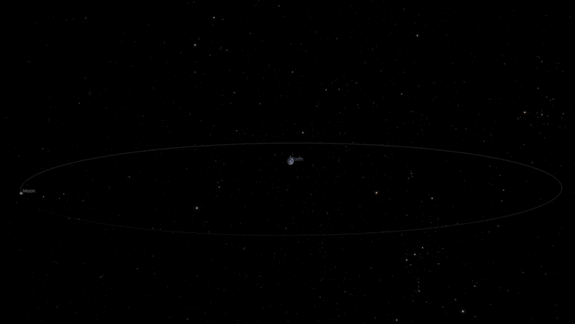Why the Asteroid Approaching Earth Was Only Spotted 5 Days Ago

Almost exactly five years ago, a truck-size celestial rockunexpectedly exploded in the atmosphere above Chelyabinsk, Russia, on Feb. 15, 2013. As town officials dealt with broken glass and hundreds injured, people worldwide asked why nobody spotted the 51-foot-across (17 meters) object sooner, in time to warn residents.
The same question could be asked of another asteroid that will whiz harmlessly past the Earth today (Feb. 9). NASA said this object, nicknamed 2018 CB, may very well be bigger than one that broke up over Chelyabinsk. The asteroid was only spotted on Sunday (Feb. 4) by the Catalina Sky Survey. Early estimates of 2018 CB's size range between 50 and 130 feet (15 and 40 m) in diameter. The object will fly by Earth at about 5:30 p.m. EST (2:30 p.m. PST) at less than 20 percent of the distance from the Earth to the moon. That's about 238,855 miles (384,400 km) from us.
"Asteroids of this size do not often approach this close to our planet — maybe only once or twice a year," Paul Chodas, manager of the Center for Near-Earth Object Studies at NASA's Jet Propulsion Laboratory in California, said in a statement from the agency.
Chelyabinsk and 2018 CB are relatively small objects in our solar system, part of a class called asteroids. (When asteroids enter the atmosphere, they're called meteors, and if pieces reach the ground, those are called meteorites.) Most of these space rocks reside in the asteroid belt, which is located between Jupiter and Mars. [When Space Attacks: The 6 Craziest Meteor Impacts]
But some asteroids skim by Earth, and they are called near-Earth objects. Many of these asteroids are discovered just days before they make their flyby. Many others glide past us unseen every few days or so, astronomer Michael Busch of the National Radio Astronomy Observatory told SPACE.com in an email in 2013.
Asteroids can sneak by us because it's tricky to track them. The first issue is their small size. Vesta, the largest known asteroid, is only 329 miles (530 km) in diameter — roughly the equivalent distance of New York City to Buffalo. Vesta, however, is an extreme case regarding size; many asteroids are only tens of feet long, or smaller. This means that already, an asteroid is harder to spot in the sky than a planet, moon or star, because it's so small.
Other factors make asteroids even harder to see. Many telescopes rely on light to make observations. Unfortunately, asteroids — especially the common carbonaceous-type asteroids that make up most of the population in our solar system — may not reflect enough light for a telescope to spot them. Asteroids near Earth also move more quickly than planets do, so telescopes need to be glued to the sky to keep up.
Sign up for the Live Science daily newsletter now
Get the world’s most fascinating discoveries delivered straight to your inbox.
The key to spotting as many asteroids as possible is to have a large network of telescopes continuously scanning the sky. These telescopes need to have enough resolving power to spot small objects. NASA does have a robust asteroid-hunting program through its Planetary Defense Coordination Office, but it's more designed for spotting big asteroids — the behemoths that could destroy a city or region. (Luckily for us, NASA hasn't announced any imminent threats yet; you can see all of its asteroid findings online at the Small-Body Database Browser.)
Right now, though, NASA is trying to catalog 90 percent of asteroids that are larger than 460 feet (140 m) wide and that will come to within about 4.65 million miles (7.48 million km) of Earth, or about 20 times the distance from Earth to the moon, according to the agency. NASA is supposed to meet that metric by 2020, but multiple reports suggest the agency will be late.
A quick comparison: An object 460 feet wide is as much as nine times larger than asteroid CB 2018 that will come by our planet today. So, compared with one of these city-obliterating asteroids, CB 2018 is much harder to spot when far away. That means telescopes generally see these small objects when the asteroids are basically knocking on our door. [Worst Ways to Die Are Pretty Weird (and Gruesome)]
If you're an amateur astronomer with a relatively large telescope, you can help NASA with spotting and tracking asteroids. These observations are coordinated through the Minor Planet Center, which has tips to get you started. Happy hunting!
Originally published on Live Science.

Elizabeth Howell was staff reporter at Space.com between 2022 and 2024 and a regular contributor to Live Science and Space.com between 2012 and 2022. Elizabeth's reporting includes multiple exclusives with the White House, speaking several times with the International Space Station, witnessing five human spaceflight launches on two continents, flying parabolic, working inside a spacesuit, and participating in a simulated Mars mission. Her latest book, "Why Am I Taller?" (ECW Press, 2022) is co-written with astronaut Dave Williams.









